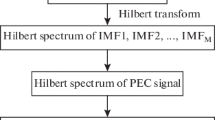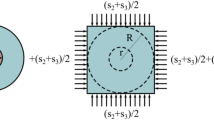Abstract
Fe-based amorphous coatings prepared by high-velocity oxy-fuel (HVOF) spraying have the advantages of good mechanical properties, high density, low porosity, and high amorphous content. The service life and bonding strength of coating greatly depend on its thickness; however, the characterization of ferromagnetic coating thickness is a very difficult problem. Pulsed eddy current (PEC) is characterized by abundant signals in frequency domains. In this paper, the thickness measurement principle of ferromagnetic coating was explored, and the typical and entropy features from PEC signals were extracted. Seven integrated learning methods were combined to quantitatively characterize the coating thickness, namely ridge regression (RR), lasso regression (LR), random forest regression (RFR), extra trees regression (ETR), gradient boosting tree regression (GBTR), addaptive boost regression (ABR) and eXtreme Gradient Boosting Regression (XGBR) algorithms. By comparing typical features with new ones, it was verified that the effective combination of entropy features and typical features could be used as effective feature parameters of eddy current signal. Statistical scores (RMSE and R2) and GridsearchCV features were used to evaluate and optimize the established model. As indicated by the results, the proposed XGBR machine learning model well predicted the coating thickness, and the relative error less than 0.05 mm.











Similar content being viewed by others
Availability of Data and Material
Not applicable.
References
Lu, W., Wang, D., Wang, Q., Yang, F., Li, T., Shi, Y., Zhang, S., Yang, B.: Sensitivity of corrosion behavior for Fe-based amorphous coating to temperature and chloride concentration. Coatings 11(3), 331 (2021)
Vignesh, S., Shanmugam, K., Balasubramanian, V., Sridhar, K., Thirumalaikumarasamy, D.: Electrochemical corrosion behaviour of HVOF sprayed iron-based amorphous metallic coatings on AISI 316 stainless steel in an NaCl solution. J. Mech. Behav. Mater. 27(3–4), 20180015 (2018)
Yasir, M., Zhang, C., Wang, W., Zhang, Z.W., Liu, L.: Tribocorrosion behavior of Fe-based amorphous composite coating reinforced by Al2O3 in 3.5% NaCl solution. J. Therm. Spray Technol. 25(8), 1554–60 (2016)
Hou, G., Zhao, X., Zhou, H., Lu, J., An, Y., Chen, J., Yang, J.: Cavitation erosion of several oxy-fuel sprayed coatings tested in deionized water and artificial seawater. Wear 311(1–2), 81–92 (2014)
Peng, Y., Zhang, C., Zhou, H., Liu, L.: On the bonding strength in thermally sprayed Fe-based amorphous coatings. Surf. Coat. Technol. 218, 17–22 (2013)
Nguyen, V.P., Dang, T.N., Le, C.C., Wang, D.A.: Effect of coating thickness on fatigue behavior of AISI 1045 steel with HVOF thermal spray and hard chrome electroplating. Journal of Thermal Spray Technology. 29(8), 1968–81 (2020)
Ranjit, S., Chung, Y., Kim, W.: Thermal behavior variations in coating thickness using pulse phase thermography. J. Korean Soc. Nondestr. Test. 36(4), 259–265 (2016)
Zhang, J., Yuan, M., Song, S.-J., Kim, H.-J.: Precision measurement of coating thickness on ferromagnetic tube using pulsed eddy current technique. Int. J. Precis. Eng. Manuf. 16(8), 1723–1728 (2015)
Wang, H., Li, W., Feng, Z.: Noncontact thickness measurement of metal films using eddy-current probes immune to distance variation. IEEE Trans. Instrum. Meas. 64(9), 2557–2564 (2014)
Wang, Y., Fan, M., Cao, B., Ye, B., Wen, D.: Measurement of coating thickness using lift-off point of intersection features from pulsed eddy current signals. NDT and E Int. 116, 102333 (2020)
Abdou, A., Bouchala, T., Abdelhadi, B., Guettafi, A., Benoudjit, A.: Nondestructive eddy current measurement of coating thickness of aeronautical construction materials. Instrum. Meas. Métrol. 18(5), 451–457 (2019)
Cheng, Y., Chen, Y., Jiang, J., Bai, L., Zhang, B.: Absorbing coating thickness measurement based on lift-off effect of eddy current testing. Int. J. Appl. Electromagn. Mech. 45(1–4), 323–330 (2014)
Li, Y., Chen, Z., Mao, Y., Qi, Y.: Quantitative evaluation of thermal barrier coating based on eddy current technique. NDT and E Int. 50, 29–35 (2012)
Kapur, J.N., Sahoo, P.K., Wong, A.K.C.: A new method for gray-level picture thresholding using the entropy of the histogram. Comput. Visi. Graph. Image Process. 29, 273–285 (1985)
Hosseini, S.M., Ghasemi-Ghalebahman, A., Azadi, M., Jafari, S.M.: Crack initiation detection in crankshaft ductile cast iron based on information entropy of acoustic emission signals under tensile loading. Eng. Fail. Anal. 127, 105547 (2021)
Shannon, C.E.: A mathematical theory of communication. Bell Syst. Tech. J. 27(3), 379–423 (1948)
Chen, G., Cao, Z.: Quantitative evaluation of eddy current distribution by relative entropy and cross entropy. Meas. Control 54(3–4), 164–169 (2021)
Liu, Z., Yao, J., He, C., Li, Z., Liu, X., Wu, B.: Development of a bidirectional-excitation eddy-current sensor with magnetic shielding: detection of subsurface defects in stainless steel. IEEE Sens. J. 18(15), 6203–16 (2018)
Xu, C., Liu, X., Wang, H., Li, Y., Jia, W., Qian, W., Quan, Q., Zhang, H., Xue, F.: A study of predicting irradiation-induced transition temperature shift for RPV steels with XGBoost modeling. Nucl. Eng. Technol. 53(8), 2610–2615 (2021)
Behmann, J., Mahlein, A.-K., Rumpf, T., Römer, C., Plümer, L.: A review of advanced machine learning methods for the detection of biotic stress in precision crop protection. Precision Agric. 16(3), 239–260 (2015)
Bernieri, A., Ferrigno, L., Laracca, M., Molinara, M.: Crack shape reconstruction in eddy current testing using machine learning systems for regression. IEEE Trans. Instrum. Meas. 57(9), 1958–1968 (2018)
Banerjee, P., Udpa, L., Udpa, S., Benson, J.: Confidence metric for signal classification in non destructive evaluation. NDT & E Int. 91, 88–96 (2017)
Vilar, R., Zapata, J., Ruiz, R.: An automatic system of classification of weld defects in radiographic images. NDT & E Int. 42(5), 467–476 (2009)
Boaretto, N., Centeno, T.M.: Automated detection of welding defects in pipelines from radiographic images DWDI. Ndt & E Int. 86, 7–13 (2017)
Porta, A., Baselli, G., Liberati, D., Montano, N., Cogliati, C., Gnecchi-Ruscone, T., Malliani, A., Cerutti, S.: Measuring regularity by means of a corrected conditional entropy in sympathetic outflow. Biol. Cybern. 78(1), 71–78 (1998)
Richman, J.S., Moorman, J.R.: Physiological time-series analysis using approximate entropy and sample entropy. Am. J. Physiol. Heart Circ. Physiol. 278(6), H2039–H2049 (2000)
Chen, W., Wang, Z., Xie, H., Yu, W.: Characterization of surface EMG signal based on fuzzy entropy. IEEE Trans. Neural Syst. Rehabil. Eng. 15(2), 266–272 (2007)
Bounoua, W., Benkara, A.B., Kouadri, A., Bakdi, A.: Online monitoring scheme using principal component analysis through Kullback-Leibler divergence analysis technique for fault detection. Trans. Inst. Meas. Control. 42(6), 1225–1238 (2020)
Gong, Y., Huang, X., Liu, Z., Deng, F., Wu, Y., He, C.: Development of a cone-shaped pulsed eddy current sensor. IEEE Sens. J. 22(4), 3129–36 (2022)
Panzone, L., Ulph, A., Areal, F., Grippo, V.: A ridge regression approach to estimate the relationship between landfill taxation and waste collection and disposal in England. Waste Manag. 129, 95–110 (2021)
Yang, X., Wen, W.: Ridge and Lasso regression models for cross-version defect prediction. IEEE Trans. Reliab. 67(3), 885–896 (2018)
Zhang, R., Li, Y., Goh, A.T., Zhang, W., Chen, Z.: Analysis of ground surface settlement in anisotropic clays using extreme gradient boosting and random forest regression models. J. Rock Mech. Geotech. Eng. 13(6), 1478–84 (2021)
Djarum, D., Ahmad, Z., Zhang, J.: River water quality prediction in Malaysia based on extra tree regression model coupled with linear discriminant analysis (LDA). Computer Aided Chemical Engineering 50, 1491–1496 (2021)
Yang, F., Wang, D., Xu, F., Huang, Z., Tsui, K.: Lifespan prediction of lithium-ion batteries based on various extracted features and gradient boosting regression tree model. J. Power Sources 476, 228654 (2020)
Koduri, S.B., Gunisetti, L., Ramesh, C.R., Mutyalu, K.V., Ganesh, D.: Prediction of crop production using adaboost regression method. J. Phys: Conf. Ser. 1228, 012005 (2019)
Acknowledgements
This study was supported in part by the National Key Research and Development Program of China under Grant 2018YFC1902404, in part by the National Natural Science Foundation of China under Grant 11772014.
Funding
Not applicable.
Ethics declarations
Competing interests
The authors have declared that no competing interests exist.
Ethical Approval
Not applicable.
Consent to Participate
Not applicable.
Consent for Publication
Published informed consent were obtained from all participants.
Additional information
Publisher's Note
Springer Nature remains neutral with regard to jurisdictional claims in published maps and institutional affiliations.
Rights and permissions
Springer Nature or its licensor (e.g. a society or other partner) holds exclusive rights to this article under a publishing agreement with the author(s) or other rightsholder(s); author self-archiving of the accepted manuscript version of this article is solely governed by the terms of such publishing agreement and applicable law.
About this article
Cite this article
Huang, X., Liu, Z., Gong, Y. et al. Quantitative Estimation of Fe-Based Amorphous Coating Thickness Based on Pulsed Eddy Current Technology. J Nondestruct Eval 42, 1 (2023). https://doi.org/10.1007/s10921-022-00912-y
Received:
Accepted:
Published:
DOI: https://doi.org/10.1007/s10921-022-00912-y




